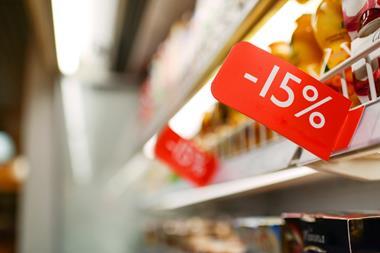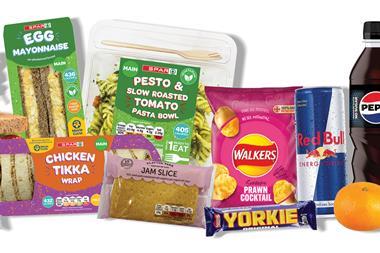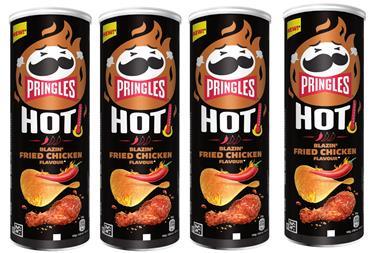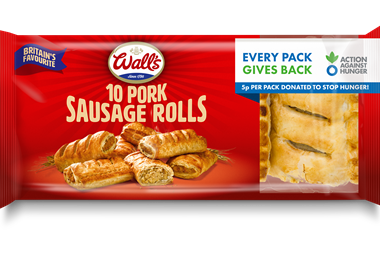It might be doom and gloom on the high street, but the peculiarly British instinct to put the kettle on in times of trouble is proving to be great news for independents. So much so that the hot beverages category in c-stores is outstripping growth in the multiples. The total category is worth £176.4m (IRI 52 weeks ending July 12, 2008), up only 2.2% in multiple grocers but growing by nearly 5% in the convenience channel.
“This is part of a longer term trend that c-store retailers can really cash in on,” says Nestlé trade communications manager Graham Walker. “There aren’t many categories where the convenience channel is outperforming the multiples at this rate,” he says.
This impressive growth is showing across all the hot beverage categories, with tea up 0.3% in c-stores, with grocers down by 0.8%, instant coffee up 7.2% (+2.6% in grocers) and hot chocolate up a massive 16% (up 6.7% in grocers).
Part of what’s fuelling growth in the coffee category, in particular, is what has been termed ‘the Starbucks effect’. Consumers have become very well educated about the variety of coffee drinks available and this is having a direct impact on their shopping habits in c-stores.
According to consumer research from HIM, 31% of convenience store shoppers pay a regular visit to a coffee shop such as Starbucks, Café Nero or Costa. Manufacturers have been quick to respond to this educated coffee palate with a premium range of ‘connoisseur’ coffees, which have been driving up the value of the market.
Jack Pipe, convenience sales director at Kraft Foods, which produces Kenco, believes that independent retailers have a real opportunity to profit from changing customer needs and emerging coffee drinking trends. He says: “Coffee consumers are becoming increasingly discerning – expecting higher quality, more indulgent and more convenient formats. This is seen by the strong growth of the premium freeze-dried sector (+6.1% value) and the super-premium freeze dried sector (+16.1% value).”
Walker says that the current economic climate could ironically provide the category with a further boost as coffee drinkers ditch their coffee-shop bought frappuccinos in favour of making a similar product at home.
“The holy grail for us would be for every c-store to stock Nescafé Original 100g, Gold Blend 100g and Cappuccino and Latte sachets. Once you stock these core products you can then easily move onto other areas,” says Walker.
Ethical and green issues continue to be a hot topic and all the major coffee brands are now pushing their Fairtrade and organic credentials. Kraft says that it leads the UK ethically sourced instant coffee market, holding a 28.1% share, and Kenco has recently announced the relaunch of its freeze-dried Rich Roast, Smooth Roast and Decaffeinated coffees, which now include beans sourced from Rainforest Alliance-certified farms. It aims to source all of its coffee beans from Rainforest Alliance Certified farms by 2010. The launch is being backed with a £7m media campaign that runs from now until March 2009. The new-look jars of Kenco Rich Roast and Smooth Roast coffee are available in £2.89 pricemarked packs, while the decaffeinated variant is pricemarked at £3.19.
According to leading Fairtrade brand Cafédirect, Fairtrade and organic coffee is outpacing growth in instant coffee in value terms, with instant coffee up 1% and Fairtrade up 6% and organic up 7%. Cafédirect, it says, has a 29.1% share of the total Fairtrade instant coffee market which is worth £24.6m and growing 4.1% year on year (Nielsen Total Coverage MAT value sales to week ending July 12, 2008). It has just launched a Classic Blend in 100g (rrp £2.85) and 200g (rrp £5.35) jars.
Cafédirect shopper marketing manager Gina Overton believes that Fairtrade products will weather any economic storm as the products are so well established in consumers’ minds. “Latest market data shows no sign that the credit crunch is impacting on ethical purchases. While organic, Fairtrade and other ethical labels will remain a fixture of the weekly shop, we are likely to see more promotional and pricing activity and greater innovation as brands strive for standout in an increasingly crowded market,” she points out.
Teff Daffu at Budgens in Tooting, South London, agrees and says that despite the looming recession, he is certainly not looking at cutting back on his pricier organic and Fairtrade coffees. In fact, he stocks 16 different types of Fairtrade and organic coffees and nine different types of Fairtrade and organic teas. He says: “What we shouldn’t forget is that people are more likely to stay at home now rather than spend money down the pub. So while we are concentrating on value as well, we certainly won’t be cutting back on these ranges.”
One company which can definitely see the potential of the c-store market is Tchibo, the world’s fourth largest coffee producer. The company started with mail order coffee in Germany in the 1940s and is known here now for its coffee shops and coffee bar concessions. However, products manager Jonathan Norman says the company is now offering packaged coffee through wholesalers to tap into the c-store market.
Norman says that initial interest has been with its Polish range, but it is extending to the English range as well. Says Norman: “People tend to think about the opportunity being with the big national mults, but they forget how big an opportunity there is in independents.”
Convenience retailers are also making sure they aren’t missing out on Britain’s love affair with fresh coffee and, for many, offering fresh coffee in-store has proven to be a real profitmaker. Companies such as Coffee Nation, which is now in more than 500 retail outlets, says that the average Coffee Nation machine generates sales of more than £40,000 a year. Its latest Compact machine offers customers a choice of cappuccino, latte, Americano and mocha.
Spar has also introduced its Censa Fairtrade coffee station, which is currently available in 39 stores in the UK and aims to be in 50 stores by end of 2009. So far feedback has been very positive.
Chris Sharrinton at Spar in Helston, Cornwall, has been offering Censa as part of its large food-to-go offering, which currently turns over £250,000 a year. The store switched from another bean-to-cup coffee 15 months ago because of quality concerns. According to Chris, quality is key with today’s coffee drinkers. “You’ve got to provide the customer with a good quality coffee every day and have to price it right. If you price it too low the customer won’t perceive it to be good quality.”
Chris charges £1.39 a cup and sells about 200 cups a week compared with 100 cups a week with the old brand. He also cross-promotes the coffee with other products, such as coffee and a hot bacon roll for £2.
Time for tea
But it seems that coffee’s success has taken its toll on tea sales with the total tea market in decline. But the current economic climate might result in a reversal of its fortunes. Tetley customer marketing controller Simon Atwell seems to think so: “Out-of-home coffee has had a bit of an upsurge. But in the home 33% of everything we drink is still tea. The beauty of tea is the price. It is still, apart from tap water, one of the cheapest beverages you can drink.”
In convenience stores Tetley holds 38.2% volume and 34.5% value share. Atwell says that as consumers get more price-conscious convenience stores should think about stocking larger packs of top tea brands. “Tetley 160 is a great opportunity because it provides c-stores with an opportunity for consumers to delay their grocery purchase, so it means when they top up they are most likely to do so from a convenience store.”
Tetley’s current ad campaign entitled ‘Everyone’s cup of tea’ aims to encourage people who love the Tetley brand to try to broaden their tea repertoire. It introduced Tetley Redbush at the end of March and Tetley says it now has a 27.5% volume share of the Redbush market in convenience stores.
Premium tea brand Twinings believes that there is still a lot of room for growth in the category and has been backing this confidence with npd this year and has spent £2m on the brand in the past 12 months. In April it relaunched all of its infusions and green teas to contain only all-natural ingredients. It has also launched its own Redbush Tea, which it says is now the fastest growing tea category.
Tetley’s Atwell says that if c-stores want to make the most of the category they also need to think about creating ‘tea occasions’ in shoppers’ minds by stocking complementary products nearby.
Hot chocolate
With the cold winter nights upon us thoughts naturally turn to cosy evenings with a cup of cocoa. Gone are the days when hot chocolate came just from Cadbury’s; this market is highly competitive and can be highly lucrative. Hot chocolate is now seen as an indulgent impulse purchase, making it ideal for the convenience market.
Nestlé’s Walker says that sales of hot chocolate in the convenience channel are outperforming the multiples by some margin. “The share of hot chocolate being sold through convenience stores is growing at 12% of all value sales (last year it was 11%).”
He adds that shoppers are also spending more on hot chocolate in c-stores with the average spend at £4.20 (up 11p – TNS Worldpanel data 52 weeks ending July 13, 2008). It’s a good time then for Nestlé to introduce its Skinny Cow hot chocolate, available a 200g tub and sachets. It comes in two flavours – indulgent chocolate and chocolate mint – and will be supported by an extensive campaign next year.
Mintel predicts that the hot chocolate market will mirror some of the trends that have taken place in coffee over the past few years which, coupled with the rising price of cocoa, will see an increase in value terms of 55% for hot chocolate products between now and 2013.
The same cannot be said of the malted drinks category which, says Mintel, is now considered quite old-fashioned by consumers. Volume sales have been falling since 2005, but Horlicks has been working hard to buck this trend with a whopping £2.7m spent on the brand in a bid to make it appeal to younger shoppers.
It has done this by introducing Horlicks Light last year and now Horlicks Extra Light, which is also available in sachet format. Horlicks Extra Light is said to have achieved £2m in value sales since it was launched earlier this year.
“This is part of a longer term trend that c-store retailers can really cash in on,” says Nestlé trade communications manager Graham Walker. “There aren’t many categories where the convenience channel is outperforming the multiples at this rate,” he says.
This impressive growth is showing across all the hot beverage categories, with tea up 0.3% in c-stores, with grocers down by 0.8%, instant coffee up 7.2% (+2.6% in grocers) and hot chocolate up a massive 16% (up 6.7% in grocers).
Part of what’s fuelling growth in the coffee category, in particular, is what has been termed ‘the Starbucks effect’. Consumers have become very well educated about the variety of coffee drinks available and this is having a direct impact on their shopping habits in c-stores.
According to consumer research from HIM, 31% of convenience store shoppers pay a regular visit to a coffee shop such as Starbucks, Café Nero or Costa. Manufacturers have been quick to respond to this educated coffee palate with a premium range of ‘connoisseur’ coffees, which have been driving up the value of the market.
Jack Pipe, convenience sales director at Kraft Foods, which produces Kenco, believes that independent retailers have a real opportunity to profit from changing customer needs and emerging coffee drinking trends. He says: “Coffee consumers are becoming increasingly discerning – expecting higher quality, more indulgent and more convenient formats. This is seen by the strong growth of the premium freeze-dried sector (+6.1% value) and the super-premium freeze dried sector (+16.1% value).”
Walker says that the current economic climate could ironically provide the category with a further boost as coffee drinkers ditch their coffee-shop bought frappuccinos in favour of making a similar product at home.
“The holy grail for us would be for every c-store to stock Nescafé Original 100g, Gold Blend 100g and Cappuccino and Latte sachets. Once you stock these core products you can then easily move onto other areas,” says Walker.
Ethical and green issues continue to be a hot topic and all the major coffee brands are now pushing their Fairtrade and organic credentials. Kraft says that it leads the UK ethically sourced instant coffee market, holding a 28.1% share, and Kenco has recently announced the relaunch of its freeze-dried Rich Roast, Smooth Roast and Decaffeinated coffees, which now include beans sourced from Rainforest Alliance-certified farms. It aims to source all of its coffee beans from Rainforest Alliance Certified farms by 2010. The launch is being backed with a £7m media campaign that runs from now until March 2009. The new-look jars of Kenco Rich Roast and Smooth Roast coffee are available in £2.89 pricemarked packs, while the decaffeinated variant is pricemarked at £3.19.
According to leading Fairtrade brand Cafédirect, Fairtrade and organic coffee is outpacing growth in instant coffee in value terms, with instant coffee up 1% and Fairtrade up 6% and organic up 7%. Cafédirect, it says, has a 29.1% share of the total Fairtrade instant coffee market which is worth £24.6m and growing 4.1% year on year (Nielsen Total Coverage MAT value sales to week ending July 12, 2008). It has just launched a Classic Blend in 100g (rrp £2.85) and 200g (rrp £5.35) jars.
Cafédirect shopper marketing manager Gina Overton believes that Fairtrade products will weather any economic storm as the products are so well established in consumers’ minds. “Latest market data shows no sign that the credit crunch is impacting on ethical purchases. While organic, Fairtrade and other ethical labels will remain a fixture of the weekly shop, we are likely to see more promotional and pricing activity and greater innovation as brands strive for standout in an increasingly crowded market,” she points out.
Teff Daffu at Budgens in Tooting, South London, agrees and says that despite the looming recession, he is certainly not looking at cutting back on his pricier organic and Fairtrade coffees. In fact, he stocks 16 different types of Fairtrade and organic coffees and nine different types of Fairtrade and organic teas. He says: “What we shouldn’t forget is that people are more likely to stay at home now rather than spend money down the pub. So while we are concentrating on value as well, we certainly won’t be cutting back on these ranges.”
One company which can definitely see the potential of the c-store market is Tchibo, the world’s fourth largest coffee producer. The company started with mail order coffee in Germany in the 1940s and is known here now for its coffee shops and coffee bar concessions. However, products manager Jonathan Norman says the company is now offering packaged coffee through wholesalers to tap into the c-store market.
Norman says that initial interest has been with its Polish range, but it is extending to the English range as well. Says Norman: “People tend to think about the opportunity being with the big national mults, but they forget how big an opportunity there is in independents.”
Convenience retailers are also making sure they aren’t missing out on Britain’s love affair with fresh coffee and, for many, offering fresh coffee in-store has proven to be a real profitmaker. Companies such as Coffee Nation, which is now in more than 500 retail outlets, says that the average Coffee Nation machine generates sales of more than £40,000 a year. Its latest Compact machine offers customers a choice of cappuccino, latte, Americano and mocha.
Spar has also introduced its Censa Fairtrade coffee station, which is currently available in 39 stores in the UK and aims to be in 50 stores by end of 2009. So far feedback has been very positive.
Chris Sharrinton at Spar in Helston, Cornwall, has been offering Censa as part of its large food-to-go offering, which currently turns over £250,000 a year. The store switched from another bean-to-cup coffee 15 months ago because of quality concerns. According to Chris, quality is key with today’s coffee drinkers. “You’ve got to provide the customer with a good quality coffee every day and have to price it right. If you price it too low the customer won’t perceive it to be good quality.”
Chris charges £1.39 a cup and sells about 200 cups a week compared with 100 cups a week with the old brand. He also cross-promotes the coffee with other products, such as coffee and a hot bacon roll for £2.
Time for tea
But it seems that coffee’s success has taken its toll on tea sales with the total tea market in decline. But the current economic climate might result in a reversal of its fortunes. Tetley customer marketing controller Simon Atwell seems to think so: “Out-of-home coffee has had a bit of an upsurge. But in the home 33% of everything we drink is still tea. The beauty of tea is the price. It is still, apart from tap water, one of the cheapest beverages you can drink.”
In convenience stores Tetley holds 38.2% volume and 34.5% value share. Atwell says that as consumers get more price-conscious convenience stores should think about stocking larger packs of top tea brands. “Tetley 160 is a great opportunity because it provides c-stores with an opportunity for consumers to delay their grocery purchase, so it means when they top up they are most likely to do so from a convenience store.”
Tetley’s current ad campaign entitled ‘Everyone’s cup of tea’ aims to encourage people who love the Tetley brand to try to broaden their tea repertoire. It introduced Tetley Redbush at the end of March and Tetley says it now has a 27.5% volume share of the Redbush market in convenience stores.
Premium tea brand Twinings believes that there is still a lot of room for growth in the category and has been backing this confidence with npd this year and has spent £2m on the brand in the past 12 months. In April it relaunched all of its infusions and green teas to contain only all-natural ingredients. It has also launched its own Redbush Tea, which it says is now the fastest growing tea category.
Tetley’s Atwell says that if c-stores want to make the most of the category they also need to think about creating ‘tea occasions’ in shoppers’ minds by stocking complementary products nearby.
Hot chocolate
With the cold winter nights upon us thoughts naturally turn to cosy evenings with a cup of cocoa. Gone are the days when hot chocolate came just from Cadbury’s; this market is highly competitive and can be highly lucrative. Hot chocolate is now seen as an indulgent impulse purchase, making it ideal for the convenience market.
Nestlé’s Walker says that sales of hot chocolate in the convenience channel are outperforming the multiples by some margin. “The share of hot chocolate being sold through convenience stores is growing at 12% of all value sales (last year it was 11%).”
He adds that shoppers are also spending more on hot chocolate in c-stores with the average spend at £4.20 (up 11p – TNS Worldpanel data 52 weeks ending July 13, 2008). It’s a good time then for Nestlé to introduce its Skinny Cow hot chocolate, available a 200g tub and sachets. It comes in two flavours – indulgent chocolate and chocolate mint – and will be supported by an extensive campaign next year.
Mintel predicts that the hot chocolate market will mirror some of the trends that have taken place in coffee over the past few years which, coupled with the rising price of cocoa, will see an increase in value terms of 55% for hot chocolate products between now and 2013.
The same cannot be said of the malted drinks category which, says Mintel, is now considered quite old-fashioned by consumers. Volume sales have been falling since 2005, but Horlicks has been working hard to buck this trend with a whopping £2.7m spent on the brand in a bid to make it appeal to younger shoppers.
It has done this by introducing Horlicks Light last year and now Horlicks Extra Light, which is also available in sachet format. Horlicks Extra Light is said to have achieved £2m in value sales since it was launched earlier this year.




























No comments yet